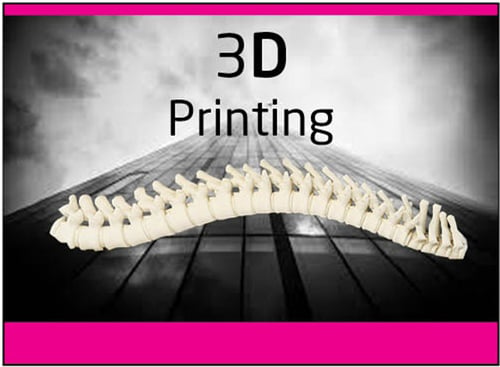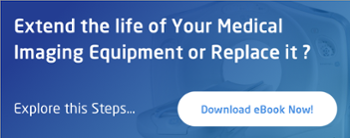If you work in the world of health care and you haven’t seen what the current generation of 3D printers can do, you really need to. Conceived as early as 1980, 3D printing was originally seen by many as an overly  complex and cost prohibitive novelty. Today, 3D printing is a thriving marketplace full of innovation and experimentation. Technological advancements in both the printers and the printing materials have helped make the creation process more affordable, more accessible and much faster.
complex and cost prohibitive novelty. Today, 3D printing is a thriving marketplace full of innovation and experimentation. Technological advancements in both the printers and the printing materials have helped make the creation process more affordable, more accessible and much faster.
Across the world, designers, teachers, students, entrepreneurs, inventors, medical professionals and hobbyists are actively redefining what’s possible with 3D printers. And what they’re printing is becoming more and more a part of our everyday lives.
A Quick Lesson in How 3D Printing Works
For those uninitiated, 3D printing works much like 2D printing but instead of ink 3D printers utilize materials like plastic, metal, or ceramic. Objects are printed layer by layer based on a digital model, which is stored in a Computer-Aided Design or CAD file. Naturally, different materials are chosen for different applications and there is a diverse range of construction materials as well as many different types of 3D printers. Some researchers are even creating 3D printers that use biomaterials to build living tissues that can be used in an assortment of different medical procedures from heart valve replacement to skin grafts. Innovations like these are quickly becoming commonplace in the world of medicine and health care.
Health Care and 3D Printing
The health care sector was an early adopter of 3D printing technologies because its potential was recognized immediately across the industry for its ability to develop fully customized and personalized tools, devices, implants, models and more. The implementation of 3D printing in the world of health care has been swift. From obvious uses like the ability to create exact replicas of anatomy to work from before committing to complex operation, to more subtle application like creating specific casts for immobilization after an injury – the impact of 3D printing is substantial.
In 2015 3D Printing is Already Being Used to Create
- Prosthetics
- Medical Implants and Sensors
- Living tissue with Blood Vessels
- Organs
- Skin, Bone and Cartilage
- Pharmaceutical Drugs
- Customizable Medical Models
- Medical Tools
Medical Imaging and 3D Printing
The process typically begins with a high resolution MRI or CT scan. Once the scan is complete the data is converted into a 3D model by using one of several openly available pieces of software specifically developed for this health care application. At this point a medical practitioner or even the patient themselves can use that file to print a 3D model of bones, organs, teeth or almost any part of the body. It seems like 3D printing technologies are being used for a seemingly limitless variety of different applications within the world of health care, and as medical grade materials and standards of 3D printing improve the opportunities will continue to grow.
Even More Uses for 3D Printing
Common uses for 3D printing that are already making an impact in the world of health care include creating quick, cost-efficient and easily modifiable prototypes that support new product development in the medical and dental industries. The technologies are also used to develop customized tools as well as molds for common tools. Other uses include the manufacturing of standard items like hip and knee implants, as well as patient specific implants that can be made quickly, on-demand. And the possibilities don’t end there. 3D printing is being used to create personalized hearing aids, orthodontics, glasses, orthotic insoles for shoes, prosthetics, braces, and one-of-a-kind implants for patients suffering from a range of diseases or accident trauma.
The Future of 3D Printing and Medical Imaging
It’s clear that advances in 3D printing and medical technology will soon redefine many of our existing medical procedures and practices. Whether it’s tissue engineering, printing 3D models for surgical practice, creating 3D bone replacements or implants – what’s becoming possible in this field is saving and improving human lives by using personalized medical devices that are printed by a machine.
Regardless of the outcome, the process will typically begin with medical imaging. High-resolution MRI and CT scans are vital to the 3D printing process in the health care world. For those in the industry it’s increasingly important to insure that MRI systems, C-Arms, CT Scanners, and PET/CT/Nuclear systems are of the highest quality and producing accurate, detailed results. That’s where Atlantis Worldwide comes in. Whether you plan on exploring the world of 3D printing to improve your practice or just need high-quality, reliable and cost effective solutions for your medical imaging needs, Atlantis Worldwide can help you prepare for the future.
For more information Contact Us Today!
Some blogs you may have missed:
- 3D Tomosynthesis, Breast MRI or Digital Mammography?
- Physicians & Social Media: Yay or Nay?
- C-Arms: The Importance of A Turnkey Solution
- 13 Ways to Decontaminate Medical Imaging Equipment & Protect Staff
- CT Scanner Slice: Handy Guide
- Interesting Medical Imaging Articles
About the author: Vikki Harmonay



